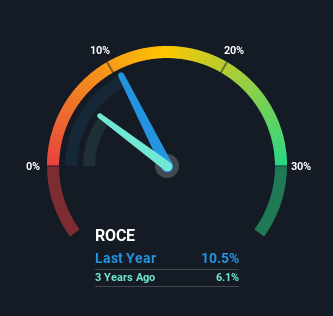Austin Engineering (ASX:ANG) Might Have The Makings Of A Multi-Bagger
If we want to find a potential multi-bagger, often there are underlying trends that can provide clues. In a perfect world, we'd like to see a company investing more capital into its business and ideally the returns earned from that capital are also increasing. Put simply, these types of businesses are compounding machines, meaning they are continually reinvesting their earnings at ever-higher rates of return. Speaking of which, we noticed some great changes in Austin Engineering's (ASX:ANG) returns on capital, so let's have a look.
What is Return On Capital Employed (ROCE)?
If you haven't worked with ROCE before, it measures the 'return' (pre-tax profit) a company generates from capital employed in its business. The formula for this calculation on Austin Engineering is:
Return on Capital Employed = Earnings Before Interest and Tax (EBIT) ÷ (Total Assets - Current Liabilities)
0.11 = AU$11m ÷ (AU$177m - AU$74m) (Based on the trailing twelve months to June 2021).
Therefore, Austin Engineering has an ROCE of 11%. In absolute terms, that's a pretty normal return, and it's somewhat close to the Machinery industry average of 9.4%.
View our latest analysis for Austin Engineering
While the past is not representative of the future, it can be helpful to know how a company has performed historically, which is why we have this chart above. If you'd like to look at how Austin Engineering has performed in the past in other metrics, you can view this free graph of past earnings, revenue and cash flow.
So How Is Austin Engineering's ROCE Trending?
Like most people, we're pleased that Austin Engineering is now generating some pretax earnings. Historically the company was generating losses but as we can see from the latest figures referenced above, they're now earning 11% on their capital employed. In regards to capital employed, Austin Engineering is using 44% less capital than it was five years ago, which on the surface, can indicate that the business has become more efficient at generating these returns. The reduction could indicate that the company is selling some assets, and considering returns are up, they appear to be selling the right ones.
On a side note, we noticed that the improvement in ROCE appears to be partly fueled by an increase in current liabilities. Essentially the business now has suppliers or short-term creditors funding about 42% of its operations, which isn't ideal. Given it's pretty high ratio, we'd remind investors that having current liabilities at those levels can bring about some risks in certain businesses.
Our Take On Austin Engineering's ROCE
In a nutshell, we're pleased to see that Austin Engineering has been able to generate higher returns from less capital. And with a respectable 78% awarded to those who held the stock over the last five years, you could argue that these developments are starting to get the attention they deserve. In light of that, we think it's worth looking further into this stock because if Austin Engineering can keep these trends up, it could have a bright future ahead.
On a final note, we've found 4 warning signs for Austin Engineering that we think you should be aware of.
For those who like to invest in solid companies, check out this free list of companies with solid balance sheets and high returns on equity.
This article by Simply Wall St is general in nature. We provide commentary based on historical data and analyst forecasts only using an unbiased methodology and our articles are not intended to be financial advice. It does not constitute a recommendation to buy or sell any stock, and does not take account of your objectives, or your financial situation. We aim to bring you long-term focused analysis driven by fundamental data. Note that our analysis may not factor in the latest price-sensitive company announcements or qualitative material. Simply Wall St has no position in any stocks mentioned.
Have feedback on this article? Concerned about the content? Get in touch with us directly. Alternatively, email editorial-team (at) simplywallst.com.

 Yahoo Finance
Yahoo Finance 
